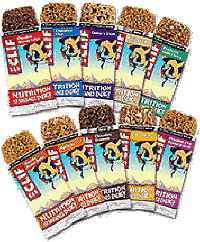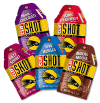 ™
™TRADITIONAL MOUNTAINEERING
™
www.TraditionalMountaineering.org
™ and also
www.AlpineMountaineering.org
™
 ™
™
FREE BASIC TO ADVANCED
ALPINE MOUNTAIN CLIMBING INSTRUCTION™
Home
| Information
| Photos
| Calendar
| News
| Seminars
| Experiences
| Questions
| Updates
| Books
| Conditions
| Links
| Search
![]()
What should I eat before a day of alpine climbing?
Good question! Mountain climbing is an aerobic sport similar in physiological cost to the same hours spent distance running, jogging, nordic skiing, bicycling, hiking fast up-hill and so on.
The intensity is governed by your speed over the ground and your elevation gain. You can not go faster than your genetic gifts and endurance training permit. Your speed must be below your anaerobic threshold - you should be able to carry on a conversation with your comrades.
Your intensity must also be based on the length and difficulty of your climb. Only the best trained and gifted athletes can maintain a near anaerobic pace for hours. If the terrain is technical, you should go slower, "well within yourself" so that you can plan and think clearly.
The pre-climb meal (or pre race meal) is well studied. Read Scott Tinley's Winning Guide to Sports Endurance, 1994, Rodale Press, pages 138 and 139. Pre-competition meals eaten at least two hours before the start, should include 60% to 70% carbohydrates, low fat, low protein, low salt, low bulk and 8 to 16 ounces of water.
Mark Twight and James Martin's Extreme Alpinism, 1999, The Mountaineers Press, Chapter 6 covers nutrition for mountaineering in twelve pages including suggestions for meals before, during and after a day
or more of concentrated alpine climbing.
What breakfast has worked well for me? I have two instant oatmeal
packets with walnuts and non fat (dried) milk, a bagel with non fat cream cheese or a couple of sticks of string cheese and the first
ClifBar of the climb, all washed down with a big glass of non-fat milk or a can of cold non fat Ultra Slim Fast if I'm starting from a car-camp trailhead. I drink
lots of water and eat some of this stuff as soon as I wake up and I try to finish eating a couple of hours before the heavy breathing will start. You
can go slower at first!
Of course, every hour or so as you go hard, you must eat simple and complex carbos (with some protein) . You must swig water when you eat to keep your stomach from taking water from your blood stream. Your stomach needs to make a soup of your food to digest it and send it out through the stomach walls into your blood stream. Your blood is required to carry both oxygen and nutrition to your muscle tissues and it needs to be thin and well hydrated.
Eating about 200 carbohydrate calories every hour will help prevent you from "hitting the wall" or "bonking" which is caused by depleting your muscle glycogen reserves. (Read those books.) Mark Twight uses GU all day long. (I tried this once and got the drizzlies!)
ClifBars are the ideal food for preventing the bonk,
when eaten -one per hour- with water or Gatorade.
The post climb meal is of great importance to enable you to keep training or
climbing, day after day. You must eat lots of carbohydrates and some protein within the first hour or so
after exercise to replace the glycogen burned in your big muscles or it may take more than twenty-four hours to top up your tanks.
There is more to know!.
Read my essay on carbo-ration and hydration during traditional alpine climbing
4 pages in pdf
![]()
Copyright© 2000-2007 by Robert Speik. All Rights Reserved.


ClifBars are the answer to the need for carbohydrates during the
climb. Click here ![]()
![]()
![]()
![]() WARNING - *DISCLAIMER!*
WARNING - *DISCLAIMER!*
Mountain climbing has inherent dangers that can, only in part, be mitigated
Read more . . .
CARBORATION AND HYDRATION
Is running the Western States 100 part of "traditional mountaineering"?
What's wrong with GORP?
Answers to the quiz!
Why do I need to count carbohydrate calories?
What should I know about having a big freeze-dried dinner?
What about carbo-ration and fluid replacement during traditional alpine climbing?
4 pages in pdf
![]()
What should I eat before a day of alpine climbing?
REAL SURVIVAL STRATEGIES
Why is the GSM digital cell phone best for backcountry and mountaineering?
FREE Clinic on Real Survival Strategies and Staying Found with Map, Compass and GPS together
What do you carry in your winter day and summit pack?
Why are "Snow Caves" dangerous?
Why are "Space Blankets" dangerous?
Why are "Emergency Kits" dangerous?
How can you avoid Hypothermia?
Missing climbers on Mount Hood, one dies of exposure, two believed killed in fall
Missing California family found, dad dies from exposure and hypothermia
Missing man survives two weeks trapped in snow-covered car
Missing snowmobile riders found, Roger Rouse dies from hypothermia
Olympic Champion Rulon Gardner lost on snowmobile!
Lost Olympic hockey player looses feet to cold injury
Expert skier lost five days near resort in North Cascades without map, compass, gps or cell phone
Mount Hood - The Episcopal School Tragedy
Mount Hood - experienced climbers rescued from snow cave
How can you learn the skills of snow camping?
Prospectus
ALPINE CLIMBING ON SNOW AND ICE
Winter mountaineering hazards - streams and lakes
Is long distance backpacking part of "traditional mountaineering"?
How long is the traditional alpine mountaineering ice axe?
What about climbing Mt. Hood?
What is a good personal description of the south side route on Mount Hood?
What should I know about travel over hard snow and ice?
How can I learn to self belay and ice axe arrest?
6 pdf pages
![]()
What should I know about snow caves?
What should I know about climbing Aconcagua?
AVALANCHE AVOIDANCE
Young Bend man dies in back county avalanche
What is an avalanche cord?
Avalanche training courses - understanding avalanche risk
How is avalanche risk described and rated by the professionals?
pdf table
How can I avoid dying in an avalanche?
Known avalanche slopes near Bend, OR?
What is a PLB?
Can I avoid avalanche risk with good gear and seminars?
pdf file
SNOWSHOES AND CRAMPONS
Why do you like GAB crampons for traditional mountaineering?
What should I know about the new snowshoe trails
What are technical snowshoes?
Which crampons are the best?
What about Boots and Shoes?
![]()
YOUR ESSENTIAL SUMMIT PACK
What are the new Ten Essential Systems?
What does experience tell us about Light and Fast climbing?
What is the best traditional alpine mountaineering summit pack?
What is Light and Fast alpine climbing?
What do you carry in your day pack?
Photos?
![]()
What do you carry in your winter day pack?
Photos?
![]()
Why are "Emergency Kits" dangerous?
What should I know about "space blankets"?
Leave no Trace with Restop bags
Mountaineering blue bag, WAG bag and Restop bag waste solutions in 1985
Where can I get a personal and a group first aid kit?
Photos?
YOUR LITE AND FAST BACKPACK
Which light backpack do you use for winter and summer?
Analysis
pdf
![]()
What would you carry in your backpack to climb Shasta or Adams?
![]()
Leave no Trace with Restop bags
Mountaineering blue bag, WAG bag and Restop bag waste solutions in 1985
What is the best traditional alpine mountaineering summit pack?
Photos of lite gear packed for a multi day approach to spring and summer summits
Backpack lite gear list for spring and summer alpine mountaineering
4 pdf pages
ESSENTIAL PERSONAL GEAR
Why is the GSM digital cell phone best for backcountry and mountaineering?
What does Steve House wear for light and fast climbing?
What clothing do you wear for Light and Fast winter mountaineering?
What do you carry in your winter day pack?
Photos?
![]()
Which digital camera do you use in the mountains?
What about Boots and Shoes?
![]()